The ‘perfect’ hunter and fisherman — if I do say so myself
 Samuel J. Hunnicutt was one of the original characters of the Smokies region before the Great Smoky Mountains National Park was founded in 1934. He is far less well known than Quill Rose, Horace Kephart, or Mark Cathey, but he was in their mold: eccentric, amusing and competent in all things having to do with outdoor life.
Samuel J. Hunnicutt was one of the original characters of the Smokies region before the Great Smoky Mountains National Park was founded in 1934. He is far less well known than Quill Rose, Horace Kephart, or Mark Cathey, but he was in their mold: eccentric, amusing and competent in all things having to do with outdoor life.
In 1883, when he was 3, the Hunnicutt family moved from Yancey County, near Burnsville, to Swain County on the North Carolina side of the Great Smokies. They resided on Deep Creek at the mouth of Bumgarner Branch just upstream from Indian Creek in present-day GSMNP; that is, about a mile north of the Deep Creek Campground area.
As a youth and grown man, Hunnicutt announced his arrival at a farmstead or camp with a yodel-like call that could be heard for a mile or more. In an era when hollering was utilized both as a utilitarian means of communication and as an art form, he was unsurpassed. But his real passion was for hunting and fishing ... endeavors at which he claimed to be “perfect.”
In 1926, at the age of 46, Hunnicutt published a 216-page, soft-covered book titled Twenty Years of Hunting and Fishing in the Great Smokies (Knoxville: S.B. Newman & Company). It contains numerous interesting illustrations by various photographers of old-time hunters and fishermen, their camps and dogs, and various structures. A second illustrated edition of 188 pages appeared in 1951 that was published in Maryville, Tenn. I have never seen the second edition; indeed, the only copy of the first edition I’ve ever encountered (and photocopied) is in the Horace Kephart collection, which is housed in Hunter Library’s Special Collections at Western Carolina University.
As a hunter, fisherman and camper, Hunnicutt was perfection itself. There was a right way and a wrong way to do everything: the right way, of course, was “The Sam Hunnicutt way.” As a writer, however, he did not overly concern himself with the niceties of style. It is one of my favorite books for that very reason. His writing is vigorous and captivating. You know immediately that Samuel J. Hunnicutt is the real deal and that you’re getting an unvarnished account of his adventures. Early on, he provides a statement of his qualifications:
Related Items
“I claim to be a perfect hunter and fisherman for game fish; I know the best kinds of hunting outfit to use; I know the best kind of gun to use for killing game and also the best dogs to use for hunting.
“I have helped kill 55 bears from dogs, I have helped catch over 500 coons with dogs, I have been at the catching of 76 foxes with foxhounds.
“These stories written in book form are true, and told just exactly as happened, as near as I can remember.”
As previously indicated, Hunnicutt had very particular notions about how to do every little thing connected with backcountry life in the pre-park Smokies. Early on he advises his readers in no uncertain terms on what to look for in a dog (“a real hound has fur instead of hair”); the proper gun to use (“a thirty-eight, forty Winchester””); how to camp (“a lean-to covered with ‘anything,’ as this saves packing cover on the trip”); how to fry trout (“place them in your frying pan all the same way with their heads either toward the handle of the pan all the opposite ... and do not use any meal or flour to roll them in as you cannot brown them properly”); and so on.
Hunnicutt also had a finely-honed sense of humor. He probably had a lot of fun arguing the finer points of these matters with his hunting and fishing cronies — a diverse group that included equally opinionated fellows like Mark Cathey, Edd Hyatt, Jim Bumgarner, Jim Cagle, Tom Clark, Print Blevins, and Lee and Henry Stinnett.
They hunted and fished all over the Smokies. These were tough men. Covering 10 or even 20 miles afoot by day or night in sunshine or rainfall through laurel hells and across raging creeks was their idea of a fine outing.
Here is an excerpt from “Story Number Eight: Bear Hunt Mad By My Two Brothers and Myself:”
So we got ready and started ... I got my oldest brother to go on Beech Ridge and make the stand; my other brother and myself took the dogs and went up through the fire-scald and across by Wooly Head Ridge and on to the Shot Beech Branch ... I turned Old Trail loose and he ran up the hill and I saw him get on a log, stick his nose in the snow and threw his head up and ‘bawl’ ... we turned the other dogs loose to see what they would do; they went to Old Trail and went to trailing with him ... My brothers and myself went with them; they went down Bear Pen Ridge and crossed the ridge, and up on the face of Briar Ridge they came to where the bear were lying above a big spruce pine tree. Here there were two bears in one bed, and then the fight began. The four dogs caught the bears in the bed while all together. When we got pretty close they moved on across Briar Ridge ... (Later) we found my brother on the side of the ridge beside a bear he had killed. The snow was bloody all around him. I asked why so much blood; he answered me saying I have killed another bear on top of the ridge and I have had the worst dog fight I ever saw; I believe they have killed Old Trail as I have not seen them since I parted them. I said if they have killed Old Trail I will kill them ... I went to the top ... and found Old Trail lying on top of the bear. I examined him before I looked at the bear and he was not hurt very bad. This revived me very much ... I told the boys if they would carry the guns and lead the dogs that I would carry the least bear to camp; they said we do not believe you can carry it alone ... I tied its legs together and put it on my back, shotpouch fashion ... and carried the bear to camp ... Columbus and myself went for the other bear ... we could only go about one hundred yards at a time, but we finally got to camp with the bear. Brother had dinner ready for us and had fried some bear liver; I enjoyed my dinner.”
Editor’s note: This column was first printed in The Smoky Mountain News in Aug. 2002.









